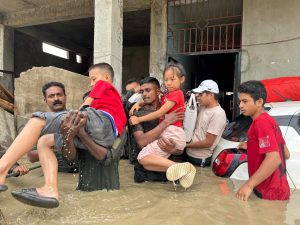Cyclone Remal has left a trail of devastation in India’s frontier region of the northeast causing deaths and disruption from flood and landslides.
As many as five states in the region were adversely impacted by the cyclone that made landfall on the Bay of Bengal coast on May 26. At least 40 people were killed and hundreds of thousands impacted by incessant rains that triggered flash floods and landslides.
Remal has been classified as a “severe” cyclonic storm, the first to occur in the Bay of Bengal during the 2024 pre-monsoon season. The frequency and intensity of these storms have worsened due to climate change.
Governments of the northeastern states and neighboring West Bengal have accelerated efforts to provide relief to the affected population.
In Manipur, the impact of the heavy downpour has been widespread, affecting both the hill and valley districts, including Imphal East, Imphal West, Kangpokpi, Bishnupur, Noney, Churachandpur, Senapati, and Kakching.
At least four people have died with 13 injured and over 100,000 people have been affected due to the massive flooding in Manipur following heavy rainfall due to Cyclone Remal. Besides Imphal, the flood has impacted Bishnupur district following breaches in the river banks. As many as 292 landslides have been reported in several areas of the state’s hill districts.
A National Disaster Response Force (NDRF) team arrived in Imphal at around 10 p.m. on Wednesday by a special Indian Air Force flight to lead the rescue operations. The Indian Army and Assam Rifles are also engaged in rescue operations and distributing essential commodities, including drinking water and medicines. The government has set up 56 relief camps where the displaced people are lodged.
More areas and populations have been affected in Assam, which is the most populous state in the country’s northeast. So far, 11 people have lost their lives and 600,000 people including over 78,000 children across 11 districts have been affected. An estimated 68,600 people have sought refuge in 187 relief camps.
The southern districts of the state, including the Barak Valley, have suffered more than the other regions. Landslides, floods and erosion have been reported from here and nearly 250,000 people are affected. Several trains have been canceled due to the rising water level in the rivers across the state. Additional personnel from the NDRF have been airlifted to the Barak Valley region to bolster the rescue and rehabilitation operation.
Mizoram has been affected more by landslides and storms than flooding. At least 29 people have been killed there with the highest toll reported from the capital city of Aizawl. Local NGOs such as the Melthum Local Council and Young Mizo Association have joined hands with the State Disaster Response Force (SDRF) for rescue and rehabilitation measures.
Chief Minister Lalduhoma has announced an allocation of 150 million Indian rupees ($1.8 million approximately) to the SDRF. Families that have lost kin in the disaster are being paid $4,792 each.
Meghalaya and Tripura have suffered less devastation compared to the other states in the northeastern region. Meghalaya reported five deaths and close to 5,000 people have been affected by storms and landslides. A portion of National Highway-6 that connects the state to Assam has collapsed near Lumshnong as storms and rains caused landslides. Transportation in the region has been severely disrupted. Vehicles were seen stranded in videos on social media.
In Tripura, around 2,500 people were rendered homeless and more than 550 houses were damaged due to the incessant rainfall, flooding and thunderstorms. Those rendered homeless have been lodged at 30 relief camps in different districts of the state. Sepahijala, Gomati, Dhalai and Khowai districts were affected the most by the cyclone. According to an official estimate, about 397 hectares of cultivable land belonging to 1,764 farmers were submerged by the flood in different districts.
Prime Minister Narendra Modi has announced compensation of $2396 from the Prime Minister’s National Relief Fund to the kin of every deceased person due to the natural disaster in the in Assam, Manipur, Meghalaya, Mizoram, Tripura and West Bengal. The Prime Minister has also announced that those injured in the aftermath of the cyclone would be given $599.

































